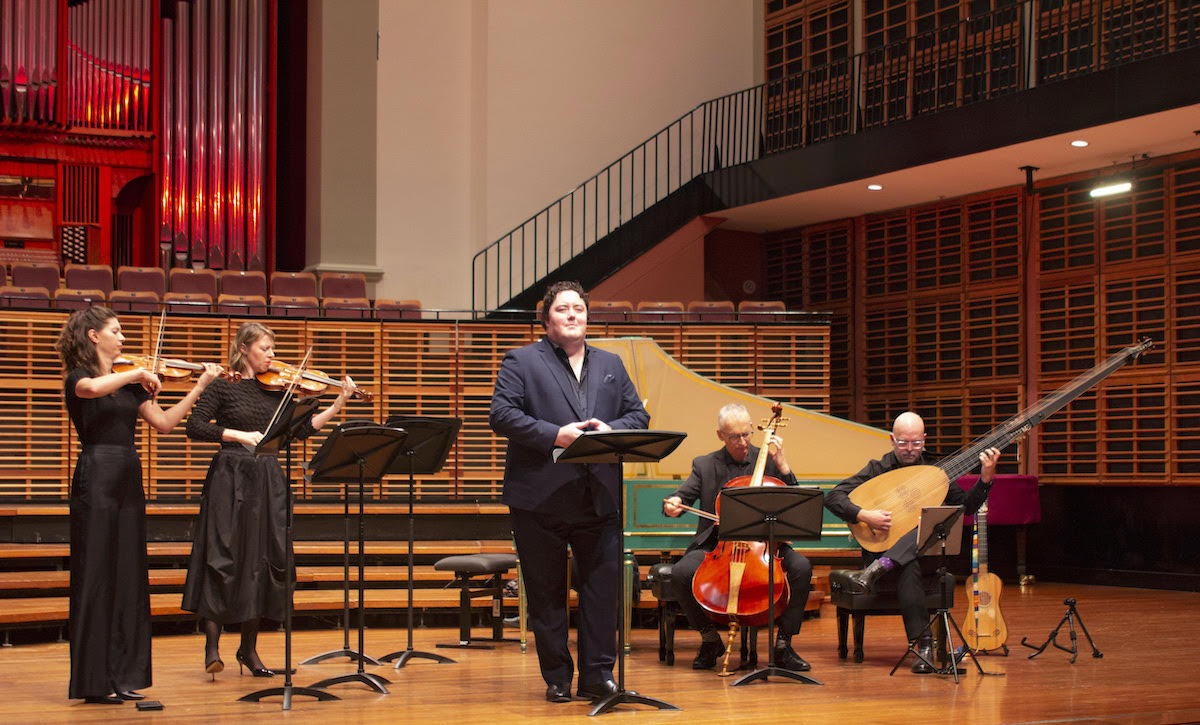The influencers selected are 12 composers from Europe and England writing for court, church and theatre, whose clout has long outlived their time and extended beyond their place. And this was before social media.
The ensemble performs a collection of short Baroque pieces and excerpts from popular composers and a few unfamiliar ones, ranging from Monteverdi, born in the mid-16th century, to Charles Avison, born in the very early 18th century.

Andrew O’Connor and Salut! Baroque. Photo © Philippa Horn
Alternating with instrumental pieces, bass-baritone Andrew O’Connor brings a swag of bass arias to the stage. Singing in Italian, Latin, German, French and English, his voice is well suited to Baroque style. Rich and weighty in the lower register, his upper register is vibrant with a sure beauty of tone. He projects calm contentment in the plangent lyricism of J. S. Bach’s aria Ich habe genug from the self-titled Cantata BWV 82 in a sinuous duet with the Baroque oboe played by Jane Downer.
O’Connor is wrathful in Polyphemus’ recitative I rage, I melt, I burn, deftly moving into the aria O ruddier than the cherry from Handel’s Acis and Galatea in a charming dialogue with recorders played by Jane Downer and Sally Melhuish; he negotiates the large leaps of the aria with verve, lightening the timbre for the secure but lightly fleeting semiquaver steps of the very Venetian coloratura of the aria Se il cor guerriero from Vivaldi’s opera Tito Manlio.

Salut! Baroque. Photo © Philippa Horn
Tranquil Sylvan scenes are conjured up in Michel Lambert’s pastoral air Ma bergère est tendre et fidèle accompanied by violinists Meg Cohen and Julia Russoniello with basso continuo. Simon Martyn-Ellis’ theorbo filters through the texture like sunlight through leaves. There is the bone-shivering aria What Power Art Thou? from Purcell’s opera King Arthur, also known as The Cold Song, espoused in part or whole by the likes of Sting, Klaus Nomi and the Pet Shop Boys.
The instrumental ensemble provides an agreeable foil between the vocal items, ably led by Meg Cohen from the Baroque violin. She plays the solo passages in the opening excerpts from Charles Avison’ Concerto No. 5 in D minor, with great delicacy. Biber’s innovative Battalia, an early attempt at humour and sonic effects in music, also draws on J S Bach’s Quodlibet from The Goldberg Variations.
The cacophonous, polytonal second movement portrays drunken soldiers; the sounds of battle are created by tapping the stringed instruments with bows, an early use of col legno and rebound pizzicato with the strings snapped off the fingerboard.
The final movement Lamento, mourning the devastation of war, is omitted, the piece ending with Die Schlact, (The Battle) featuring the stile concitato or “agitated style”, developed by Monteverdi to depict the heat of conflict.
There are instrumental excerpts from The Tempest, by Matthew Locke, who pioneered the use of volume markings on the score in English music, excerpts from Rameau’s Les Indes Galante and two movements from Georg Philipp Telemann’s Concerto in G major for Viola, one of the first known concertos for viola, if not the first.
Karina Schmitz is the soloist, playing the first two movements of this four-movement concerto on the Baroque viola, the Largo with broad sweeping brushstrokes, and the Allegro, vivacious and virtuosic.

Andrew O’Connor and Salut! Baroque. Photo © Philippa Horn
The whole ensemble gathers for the buoyant finale, Monteverdi’s madrigal Damigella tutta bella from the collection Scherzi Musicali. Although it is written for three voices and instruments, O’Connor takes a single vocal line in dialogue with Cohen on the violin. It is a merry tune with syncopated rhythms and passionate words, ending the hour-long presentation on an effervescent high.
Notes, biographies, text and translations are in the program adorned with dramatic artwork. The concept of The Influencers and the music that it brings together is a clever idea. However, the programming of excerpts and rather than whole pieces and the brevity of others preclude the opportunity to really dwell on the music and absorb its style.











Comments
Log in to join the conversation.